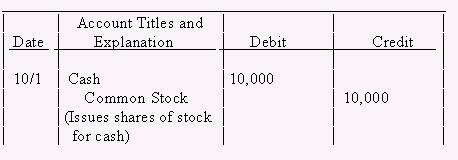Economic events that require recording in financial statements
The Accounting Information System
- Analyze the effect of business transactions on the basic accounting equation.
- Explain what an account is and how it helps in the recording process.
- Define debits and credits and explain how they are used to record business transactions.
- Identify the basic steps in the recording process.
- Explain what a journal is and how it helps in the recording process.
- Explain what a ledger is and how it helps in the recording process.
- Explain what posting is and how it helps in the recording process.
- Explain the purposes of a trial balance.
- nature of the company’s business
- types of transactions
- company size
- information demands of management and others.
- economic events that require recording in the financial statements
- occur when assets, liabilities, or stockholders’ equity items change as a result of some economic event
- Account - an individual accounting record of increases and decreases in a specific asset, liability, or stockholders'equity item.
- An account consists of three parts: (1) the title of the account, (2) a left or debit side, and (3) a right or a credit side.
- It is referred to as a T account because the alignment of the parts of the account resemble the letter T,
- The term debit means left, and credit means right.
- Debit is abbreviated Dr. and credit is abbreviated Cr.
- The act of entering an amount of the left side of an account is called debiting. Making an entry on the right side is called crediting.
- When the totals of the two sides are compared, an account will have a debit balance if the left side (dr side) is greater. Conversely, the account will have a credit balance if the right side (cr side) is greater.
- Double-entry accounting
- For each transaction, the debits must equal the credits and the accounting equation must be kept in balance.This helps to ensure the accuracy of the recorded amounts and helps to detect errors.
- Debits increase assets, expenses and dividends. Debits decrease liabilities, common stock and revenues.
- Credits decrease assets,expenses and dividends. Credits increase liabilities, stockholders’ equity, and revenues.
- Analyze each transaction in terms of its effect on the accounts.
- A source document, such as a sales slip, a check, a bill, or a cash register tape provides evidence of the transaction.
- Enter the transaction information in the journal.
- Transfer the journal information to the appropriate accounts in the ledger (book of accounts).
An example of a proper journal entry follows. Return to the example of Sierra. On October 1 the owner invested $10,000 cash in the business, in exchange for $10,000 of Sierra Corporation common stock.Both Cash and Common Stock would increase by $10,000.This transaction would be recorded in the following manner:

Study Ob jective 6 - What a Ledger is and How it Helps in the Recording Process
- The entire group of accounts maintained by a company is referred to as the ledger.
- The general ledger contains all of the asset, liability and stockholders' equity accounts.
- Information in the ledger provides management with the balances in various accounts.
- Accounts in the general ledger are listed in the chart of accounts.
We typically think of foreign correspondents keeping journals. Journals are actually diaries. You can think of the journal used in accounting as a diary that has a chronological listing of the financial transactions of a business. Accounts facilitate the classification of financial information. For example, all of the transactions pertaining to cash may be found in the cash account. The same is true for all of the other accounts, accounts receivable, inventory, etc.
Study Ob jective 7 - What Posting is and How it Helps in the Recording Process
Posting is the process of transferring journal entries to the ledger accounts.
Posting accumulates the effects of journal transactions in the individual ledger accounts.
Study Ob jective 8 - The Purpose of a Trial Balance
- A trial balance is a list of accounts and their balances on a specific date.
- The primary purpose of the trial balance is to prove the mathematical equality of debits and credits after posting.
- A trial balance
- uncovers errors in journalizing and posting.
- is useful in the preparation of financial statements.
- is limited in that it will balance but not uncover errors when:
- A transaction is not journalized.
- A correct journal entry is not posted.
- A journal entry is posted twice,
- Incorrect accounts are used in journalizing and posting, or
- Offsetting errors are made in recording the amount of a transaction.


